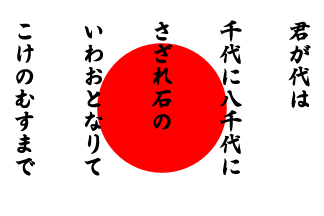![[Japan]](../images/j/jp.gif) image
by Antonio Martins
image
by Antonio MartinsProportions: 2:3

Last modified: 2008-03-22 by phil nelson
Keywords: japan | sun (red) | rising sun | ainu | roundel: star |
Links: FOTW homepage |
search |
disclaimer and copyright |
write us |
mirrors
![[Japan]](../images/j/jp.gif) image
by Antonio Martins
image
by Antonio Martins
Proportions: 2:3
![]()
ISO Code: JP JPN 392
FIPS 10-4 Code: JA
MARC Code: ja
IOC Code: JPN
See also:
Outside Links:
The symbol in the centre of the "Hi-no-maru" (the Japanese national flag) is
the state "Mon" or emblem. It has been the state symbol of Japan for centuries.
The flag became the National Flag following the Meiji Restoration in 1868. It
never had rays.
Graham Bartram, 09 November 1998
A long time dispute was concluded on which flag should be official/legal national
flag whether decree no 651 of Oct 3, 1870 (2:3, 3/5, in the center) originally
legislated for the Japanese Naval flag or decree no 57 of Jan 27
1870 (7:10, 3/5, 1/100 towards hoist) originally legislated for the Japanese
Merchant flag.
Nozomi Kariyasu, 5 August 1999, 22 January 2000
While Album des pavillons [pay00] gives
the Pantone color as red 186C, I have a fabric sample on file which suggests the
use of Pantone 193C.
Christopher Southworth, 22 December 2005
From: Japan: an illustrated encyclopedia Vol. 2 (M-Z):
national flag
(kokki). The national flag of Japan has a crimson disc, symbolizing the sun, in the center of a white field. It is popularly known as the Hinomaru (literally, "sun disc"). It is said that at the time of the Mongol Invasions of Japan (1274 and 1281) the priest Nichiren presented a sun flag to the shogun. The Tokugawa shogunate (1603-1867) adopted the flag for its ships in the early 1600s. In the mid-19th century the shogunate decreed that all Japanese ships fly flags with the sun on a white field. In 1870 the Meiji government officially designated it for use on Japanese merchant and naval ships. It has never been officially designated as the national flag; however, it has become so by customary use. The "rising-sun" flag with 16 rays used by the former Japanese navy and by the present Maritime Self Defense Forces is a military service flag and should not be confused with the national flag.
Beside a drawing of the flag is the following text:
Marcus Schmöger, 27 August 2001The design and proportions of Japan's national flag were fixed in 1870 by the Meiji government. The vertical to horizontal ratio was set at 2:3, the disc was to be placed at the exact center, and the diameter of the disc was to equal three-fifths of the vertical measurement of the flag.
The name of Nichiren means the sun and lotus in English (Nichi = Nihon = the sun; Ren = lotus ) and the lotus is a typical symbol of Buddhism. That is why he gave the sun (and lotus) to the Shogun who at that time was politically opposed to the Emperor (who was a God in Shintoism). Nichiren is said the greatest Buddhist in Japan because a majority of Japanese are not Shintoist but Buddhist. The Nichiren was formed his organization which is now called Soka-Gakkai whose political part is Komei-tou which is composed of the present Japanese cabinet.
I think he believed his flag could help the Shogun, who had military power,
to save Japan and the people from Mongol Invasion. He could not find any reason
for him to give his flag to the Emperor who is believed the God and son of
the Sun but who had no ability to defeat Mongolian.
Nozomi Kariyasu, 29 August 2001
Nichiren's purpose was to motivate the political powers to abandon the
more popular Buddhist sects and to accept the Lotus Sutra as the one sure
way to save Japan. His was a religious and philosophical movement, not a political
one. At the same time he issued to the government a treatise entitled "Rissho
Ankoku Ron" which predicted great disaster for Japan should they not retreat
from the heretical (popular) Buddhist sects and accept his teachings.
Bruce Ward, 2 September 2001
At http://www1.jca.apc.org/anti-hinokimi/archive/chronology/senzen/ (a Japanese language webpage) there is a chronology of the history of Japanese flags, anthems, et cetera, based on contemporary official documents.
A few interesting things:
Miles Li, 30 November 2006
![[Flag in decree 57, 1870]](../images/j/jp~1870.gif)
The Prime Minister's Proclamation No. 57 issued on January 27 in the 3rd Year of Neiji (1870):
Regulations of Merchant Ship (abridged)1. The national flag:
This shall not be removed and even a ferryboat shall keep it hoisted.
Hoist it at 8 a.m. every morning and haul it down at sunset every evening. In case of non-hoisting of the national flag it is customary of the international law that no plea is justified it treated as pirates.2. The dimensions of the national flag:
The ratio of the hoist and fly 7:10.
The diameter of the disc: three fifths of the hoist length of the flag locating in the center.Regulated as above for strict observances.
Ministry of Home Affairs
Ministry of Foreign Affairs
Source: Japanese National flag - Japanese National symbol Marks.
Tokyo: Kokki Kyokai (National Flag Association), circa 1970. p. 3.
Jos Poels, 18 January 1996
Adopted: May, 1870
Jaume Ollé, 17 January 2000

image by Zachary Harden, 22 February 2008
Recently, I discovered a Japanese flag imposed with writing on it on
Yahoo Auctions. The auction
mentions the text imprinted on the flag is the lyrics of Kimi ga Yo, the Japanese
national anthem. I have seen this as patches and stickers, but this is
the first time I have actually seen it on cloth.
Zachary Harden, 22 February 2008
A red disk bordered with white.
Just to mention, Military Aircraft
Insignia of the World explains that such a roundel was used
since the establishment of Japanese military aviation. It mentions
that sometimes the disk was also bordered yellow, and that on the
Home Defence aircrafts in 1944-45 the red disk was on white square
field. After the surrender in 1945, the Allies prescribed that all
Japanese aircrafts have their roundels painted white with green
cross throughout.
eljko Heimer, 4 March 2002
The Japanese Air Force was formed in 1911 and a year later a
naval air arm was formed. After a period of no military aviation
in Japan, the Japan Air Self-Defense Force (Nihon Koku-Jieitai)
was formed on 1 July 1954 together with Japan Maritime Self-Defense
Force (Kaijyo Jieitai) and Japan Ground Self-Defense Force (Rikujo
Jieitai) with their air arms.
Dov Gutterman, 18 June 2004
 image by Marc Pasquin, 4 May 2006
image by Marc Pasquin, 4 May 2006
Flipping through a book on the history of aviation, I came upon the reproduction of a French poster from 1915 that showed some planes of the world. Those that are visible (its only part of the poster) carry what you would expect in terms of markings but Japan was unusual:
Japan: a red 5-pointed star on a white circle. The star was
part of the uniform of the Japanese so this might explain its
use. the army probably switched to the more familiar one after
the Russian revolution to avoid confusion.
Marc Pasquin, 4 May 2006